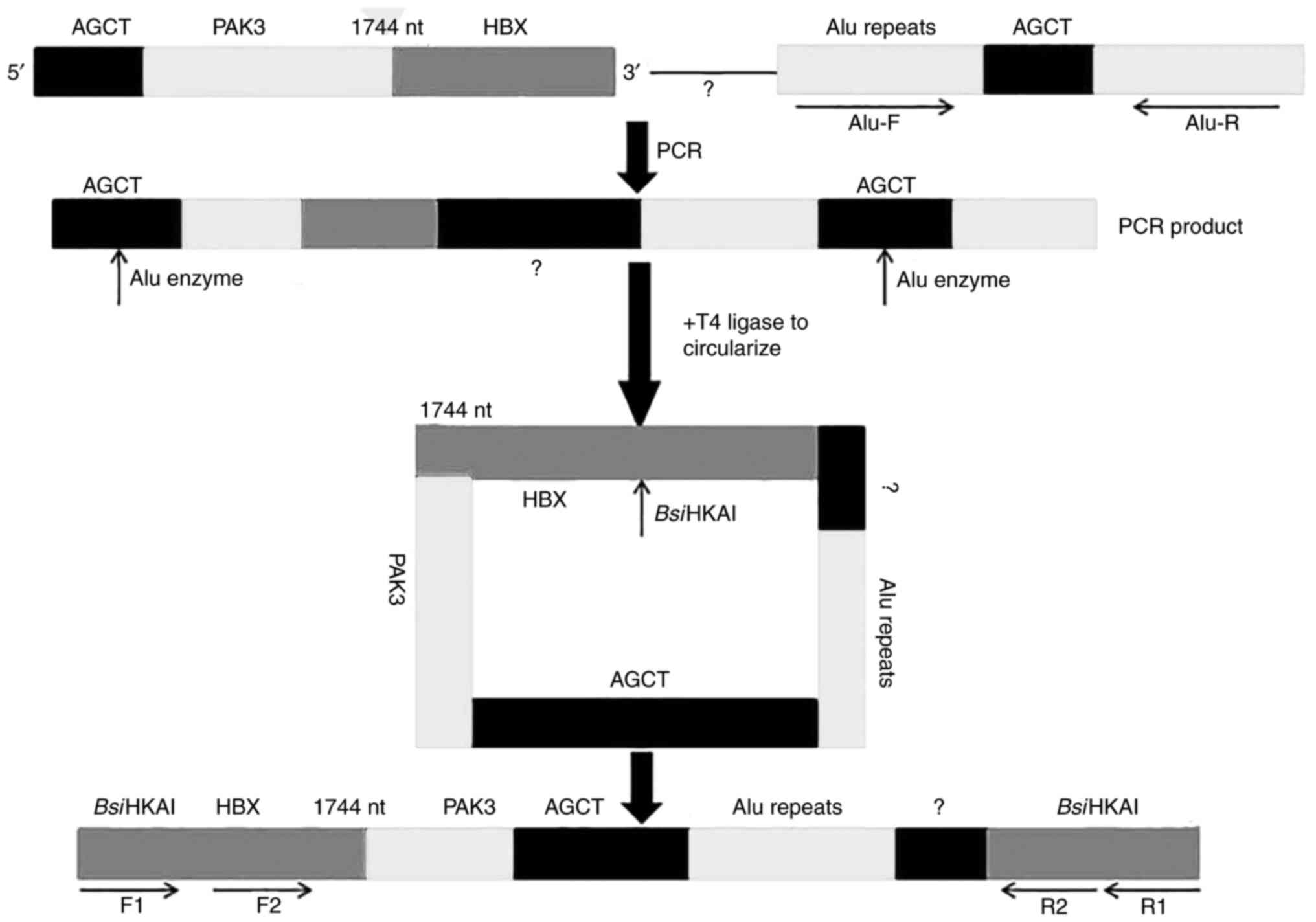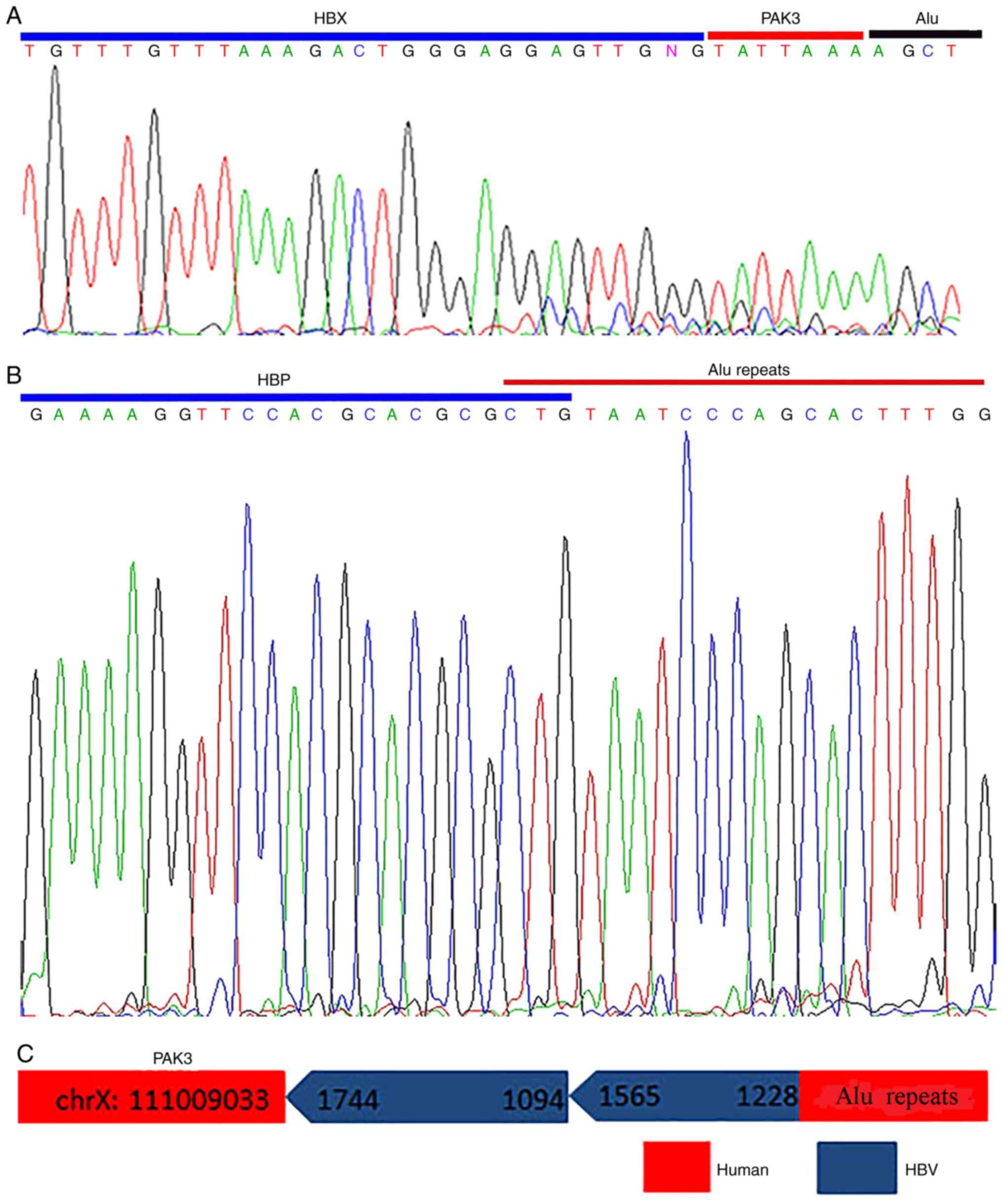|
1
|
GBD 2016 Causes of Death Collaborators, .
Global, regional, and national age-sex specific mortality for 264
causes of death, 1980–2016: A systematic analysis for the global
burden of disease study 2016. Lancet. 390:1151–1210. 2017.
View Article : Google Scholar : PubMed/NCBI
|
|
2
|
Ruan P, Zhou B, Dai X, Sun Z, Guo X, Huang
J and Gong Z: Predictive value of intrahepatic hepatitis B virus
covalently closed circular DNA and total DNA in patients with acute
hepatitis B and patients with chronic hepatitis B receiving
anti-viral treatment. Mol Med Rep. 9:1135–1141. 2014. View Article : Google Scholar : PubMed/NCBI
|
|
3
|
Lin SY, Zhang A, Lian J, Wang J, Chang TT,
Lin YJ, Song W and Su YH: Recurrent HBV integration targets as
potential drivers in hepatocellular carcinoma. Cells. 10:12942021.
View Article : Google Scholar : PubMed/NCBI
|
|
4
|
Hu X, Jiang J, Ni C, Xu Q, Ye S, Wu J, Ge
F, Han Y, Mo Y, Huang D and Yang L: HBV integration-mediated cell
apoptosis in HepG2.2.15. J Cancer. 10:4142–4150. 2019. View Article : Google Scholar : PubMed/NCBI
|
|
5
|
Tu T, Budzinska MA, Vondran FWR, Shackel
NA and Urban S: Hepatitis B virus DNA integration occurs early in
the viral life cycle in an in vitro infection model via sodium
taurocholate cotransporting polypeptide-dependent uptake of
enveloped virus particles. J Virol. 92:e020007–17. 2018. View Article : Google Scholar
|
|
6
|
Minami M, Poussin K, Bréchot C and
Paterlini P: A novel PCR technique using Alu-specific primers to
identify unknown flanking sequences from the human genome.
Genomics. 29:403–408. 1995. View Article : Google Scholar : PubMed/NCBI
|
|
7
|
Ding D, Lou X, Hua D, Yu W, Li L, Wang J,
Gao F, Zhao N, Ren G, Li L and Lin B: Recurrent targeted genes of
hepatitis B virus in the liver cancer genomes identified by a
next-generation sequencing-based approach. PLoS Genet.
8:e10030652012. View Article : Google Scholar : PubMed/NCBI
|
|
8
|
Lau CC, Sun T, Ching AK, He M, Li JW, Wong
AM, Co NN, Chan AW, Li PS, Lung RW, et al: Viral-human chimeric
transcript predisposes risk to liver cancer development and
progression. Cancer Cell. 25:335–349. 2014. View Article : Google Scholar : PubMed/NCBI
|
|
9
|
Svicher V, Salpini R, Piermatteo L,
Carioti L, Battisti A, Colagrossi L, Scutari R, Surdo M,
Cacciafesta V, Nuccitelli A, et al: Whole exome HBV DNA integration
is independent of the intrahepatic HBV reservoir in HBeAg-negative
chronic hepatitis B. Gut. 70:2337–2348. 2021. View Article : Google Scholar : PubMed/NCBI
|
|
10
|
Gao Z, Zhong M, Ye Z, Wu Z, Xiong Y, Ma J,
Chen H, Zhu Y, Yang Y, Zhao Y and Zhang Z: PAK3 promotes the
metastasis of hepatocellular carcinoma by regulating EMT process. J
Cancer. 13:153–161. 2022. View Article : Google Scholar : PubMed/NCBI
|
|
11
|
Ruan P, Dai X, Sun J, He C, Huang C, Zhou
R and Chemin I: Integration of hepatitis B virus DNA into
p21-activated kinase 3 (PAK3) gene in HepG2.2.15 cells. Virus
Genes. 56:168–173. 2022. View Article : Google Scholar : PubMed/NCBI
|
|
12
|
Dandri M, Burda MR, Bürkle A, Zuckerman
DM, Will H, Rogler CE, Greten H and Petersen J: Increase in de novo
HBV DNA integrations in response to oxidative DNA damage or
inhibition of poly(ADP-ribosyl)ation. Hepatology. 35:217–223. 2002.
View Article : Google Scholar : PubMed/NCBI
|
|
13
|
Tu T and Jilbert AR: Detection of
hepatocyte clones containing integrated hepatitis B virus DNA using
inverse nested PCR. Methods Mol Biol. 1540:97–118. 2017. View Article : Google Scholar : PubMed/NCBI
|
|
14
|
Sells MA, Chen ML and Acs G: Production of
hepatitis B virus particles in Hep G2 cells transfected with cloned
hepatitis B virus DNA. Proc Natl Acad Sci USA. 84:1005–1009. 1987.
View Article : Google Scholar : PubMed/NCBI
|
|
15
|
Yuan S, Tanzeel Y, Tian X, Zheng D,
Wajeeha N, Xu J, Ke Y, Zhang Z, Peng X, Lu L, et al: Global
analysis of HBV-mediated host proteome and ubiquitylome change in
HepG2.2.15 human hepatoblastoma cell line. Cell Biosci. 11:752021.
View Article : Google Scholar : PubMed/NCBI
|
|
16
|
Oikawa R, Watanabe Y, Yotsuyanagi H,
Yamamoto H and Itoh F: DNA methylation at hepatitis B virus
integrants and flanking host mitochondrially encoded cytochrome C
oxidase III. Oncol Lett. 24:4242022. View Article : Google Scholar : PubMed/NCBI
|
|
17
|
Yan H, Yang Y, Zhang L, Tang G, Wang Y,
Xue G, Zhou W and Sun S: Characterization of the genotype and
integration patterns of hepatitis B virus in early- and late-onset
hepatocellular carcinoma. Hepatology. 61:1821–1831. 2015.
View Article : Google Scholar : PubMed/NCBI
|
|
18
|
Li W, Cui X, Huo Q, Qi Y, Sun Y, Tan M and
Kong Q: Profile of HBV integration in the plasma DNA of
hepatocellular carcinoma patients. Curr Genomics. 20:61–68. 2019.
View Article : Google Scholar : PubMed/NCBI
|
|
19
|
Ye DZ and Field J: PAK signaling in
cancer. Cell Logist. 2:105–116. 2012. View Article : Google Scholar : PubMed/NCBI
|
|
20
|
Zhou N, Ding B, Agler M, Cockett M and
McPhee F: Lethality of PAK3 and SGK2 shRNAs to human papillomavirus
positive cervical cancer cells is independent of PAK3 and SGK2
knockdown. PLoS One. 10:e01173572015. View Article : Google Scholar : PubMed/NCBI
|
|
21
|
Wang GJ, Yu TY, Li YR, Liu YJ and Deng BB:
Circ_0000190 suppresses gastric cancer progression potentially via
inhibiting miR-1252/PAK3 pathway. Cancer Cell Int. 20:3512020.
View Article : Google Scholar : PubMed/NCBI
|
|
22
|
Wu HY, Yang MC, Ding LY, Chen CS and Chu
PC: p21-activated kinase 3 promotes cancer stem cell phenotypes
through activating the Akt-GSK3β-β-catenin signaling pathway in
pancreatic cancer cells. Cancer Lett. 456:13–22. 2019. View Article : Google Scholar : PubMed/NCBI
|
|
23
|
Santamaria PG, Moreno-Bueno G, Portillo F
and Cano A: EMT: Present and future in clinical oncology. Mol
Oncol. 11:718–738. 2017. View Article : Google Scholar : PubMed/NCBI
|
|
24
|
Hama N, Totoki Y, Miura F, Tatsuno K,
Saito-Adachi M, Nakamura H, Arai Y, Hosoda F, Urushidate T, Ohashi
S, et al: Epigenetic landscape influences the liver cancer genome
architecture. Nat Commun. 9:16432018. View Article : Google Scholar : PubMed/NCBI
|
|
25
|
Mason WS, Low HC, Xu C, Aldrich CE,
Scougall CA, Grosse A, Clouston A, Chavez D, Litwin S, Peri S, et
al: Detection of clonally expanded hepatocytes in chimpanzees with
chronic hepatitis B virus infection. J Virol. 83:8396–8408. 2009.
View Article : Google Scholar : PubMed/NCBI
|
|
26
|
Yang L, Ye S, Zhao X, Ji L, Zhang Y, Zhou
P, Sun J, Guan Y, Han Y, Ni C, et al: Molecular characterization of
HBV DNA integration in patients with hepatitis and hepatocellular
carcinoma. J Cancer. 9:3225–3235. 2018. View Article : Google Scholar : PubMed/NCBI
|
|
27
|
Ruan P, Dai XF, Sun J, He C, Huang C, Zhou
R, Cao Z and Ye L: Different types of viral-host junction found in
HBV integration breakpoints in HBV-infected patients. Mol Med Rep.
19:1410–1416. 2019.PubMed/NCBI
|
|
28
|
Li W, Zeng X, Lee NP, Liu X, Chen S, Guo
B, Yi S, Zhuang X, Chen F, Wang G, et al: HIVID: An efficient
method to detect HBV integration using low coverage sequencing.
Genomics. 102:338–344. 2013. View Article : Google Scholar : PubMed/NCBI
|
|
29
|
Hu Z, Zhu D, Wang W, Li W, Jia W, Zeng X,
Ding W, Yu L, Wang X, Wang L, et al: Genome-wide profiling of HPV
integration in cervical cancer identifies clustered genomic hot
spots and a potential microhomology-mediated integration mechanism.
Nat Genet. 47:158–163. 2015. View Article : Google Scholar : PubMed/NCBI
|
|
30
|
Tadi SK, Sebastian R, Dahal S, Babu RK,
Choudhary B and Raghavan SC: Microhomology-mediated end joining is
the principal mediator of double-strand break repair during
mitochondrial DNA lesions. Mol Biol Cell. 27:223–235. 2016.
View Article : Google Scholar : PubMed/NCBI
|
|
31
|
Lamouille S, Xu J and Derynck R: Molecular
mechanisms of epithelial-mesenchymal transition. Nat Rev Mol Cell
Biol. 15:178–196. 2014. View Article : Google Scholar : PubMed/NCBI
|
|
32
|
Mladenov E, Magin S, Soni A and Iliakis G:
DNA double-strand-break repair in higher eukaryotes and its role in
genomic instability and cancer: Cell cycle and
proliferation-dependent regulation. Semin Cancer Biol. 37–38.
51–64. 2016.PubMed/NCBI
|
|
33
|
Thiery JP: Epithelial-mesenchymal
transitions in development and pathologies. Curr Opin Cell Biol.
15:740–746. 2003. View Article : Google Scholar : PubMed/NCBI
|
|
34
|
Gui Y, Khan MGM, Bobbala D, Dubois C,
Ramanathan S, Saucier C and Ilangumaran S: Attenuation of
MET-mediated migration and invasion in hepatocellular carcinoma
cells by SOCS1. World J Gastroenterol. 23:6639–6649. 2017.
View Article : Google Scholar : PubMed/NCBI
|
|
35
|
Zhang C, Zhang X, Xu R, Huang B, Chen AJ,
Li C, Wang J and Li XG: TGF-β2 initiates autophagy via Smad and
non-Smad pathway to promote glioma cells' invasion. J Exp Clin
Cancer Res. 36:1622017. View Article : Google Scholar : PubMed/NCBI
|
|
36
|
Ahmadi A, Najafi M, Farhood B and
Mortezaee K: Transforming growth factor-β signaling: Tumorigenesis
and targeting for cancer therapy. J Cell Physiol. 234:12173–12187.
2019. View Article : Google Scholar : PubMed/NCBI
|
|
37
|
Zhao LH, Liu X, Yan HX, Li WY, Zeng X,
Yang Y, Zhao J, Liu SP, Zhuang XH, Lin C, et al: Genomic and
oncogenic preference of HBV integration in hepatocellular
carcinoma. Nat Commun. 7:129922016. View Article : Google Scholar : PubMed/NCBI
|
|
38
|
Schraufstatter IU, Hyslop PA, Hinshaw DB,
Spragg RG, Sklar LA and Cochrane CG: Hydrogen peroxide-induced
injury of cells and its prevention by inhibitors of
poly(ADP-ribose) polymerase. Proc Natl Acad Sci USA. 83:4908–4912.
1986. View Article : Google Scholar : PubMed/NCBI
|
|
39
|
Schraufstatter IU, Hyslop PA, Jackson J
and Cochrane CC: Oxidant injury of cells. Int J Tissue React.
9:317–324. 1987.PubMed/NCBI
|
|
40
|
Mason WS, Jilbert AR and Summers J: Clonal
expansion of hepatocytes during chronic woodchuck hepatitis virus
infection. Proc Natl Acad Sci USA. 102:1139–1144. 2005. View Article : Google Scholar : PubMed/NCBI
|



















